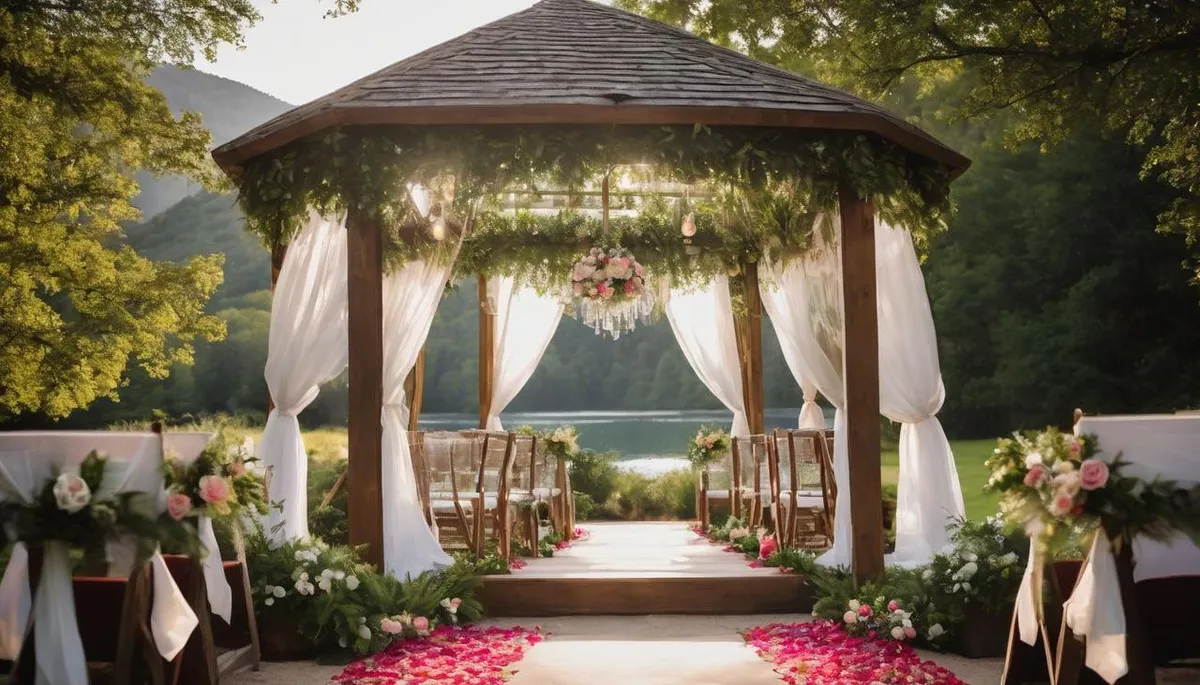
Planning a wedding that honors both Jewish and Catholic traditions can feel overwhelming. This unique blend of faiths brings its own set of challenges and rewards. Our guide offers practical steps to create a ceremony that respects both religions equally.
Let's make your special day unforgettable.
Key Takeaways
- Find an interfaith officiant who knows both Jewish and Catholic traditions to help create a respectful and inclusive ceremony.
- Blend elements from both faiths, like the ketubah signing from Jewish customs and readings from scripture in Catholic practices, for a ceremony that honors each partner's religious background.
- Communicate openly with your families and guests about the blend of traditions to ensure everyone feels included and respected during the celebration.
- Address any potential conflicts or concerns early on by discussing them openly. Seek compromises that honor both traditions without causing discomfort.
- Keep an open mind throughout planning. Respect each other’s beliefs and values to successfully blend Jewish and Catholic customs into your wedding.
Understanding the Jewish and Catholic Traditions
Understand the significance of a Jewish wedding and Catholic wedding customs. Explore how to blend and embrace both traditions for an interfaith ceremony.
The significance of a Jewish wedding
A Jewish wedding is a deeply meaningful ceremony that combines ancient traditions with the celebration of love and commitment. It marks not just the union of two individuals, but also their families and communities.
This event is rich in rituals, including the signing of the Ketubah (marriage contract), the wearing of the Kippah (head covering), and standing under the Chuppah (wedding canopy).
These elements symbolize various aspects of life and marriage within Jewish culture.
Key moments like the breaking of a glass remind everyone present about enduring love even in times of hardship. The couple's circling each other represents building a new household together, grounded in mutual respect and shared values.
Such customs bring depth to the ceremony, connecting it to thousands of years of history while looking forward to future generations.
Catholic wedding customs
Catholic wedding customs are steeped in tradition and hold deep significance for those practicing the faith. The ceremony often takes place within a church, with an ordained priest officiating.
Key elements of a Catholic wedding include the exchange of vows, readings from the Bible, and the blessing of rings. Additionally, there may be the lighting of a unity candle to symbolize the joining of two families through marriage.
The ceremony culminates with prayers and blessings for the couple's union.
Interfaith couples incorporating Catholic wedding customs into their interfaith ceremonies can seek guidance from both religious leaders to ensure that traditions are respectfully upheld while embracing inclusivity.
Blending the Two Faiths
Embrace and incorporate both Jewish and Catholic traditions into the wedding ceremony. Find a harmonious balance between the two faiths to create a meaningful and inclusive experience for everyone involved.
Embracing and incorporating both traditions
In blending the Jewish and Catholic traditions for an interfaith wedding, couples can incorporate meaningful elements from both faiths. This may involve including Jewish wedding customs like the signing of the ketubah and the breaking of the glass, while also integrating Catholic traditions such as a unity candle ceremony or specific prayers.
By carefully selecting rituals and symbols that hold significance in both faiths, couples can create a harmonious ceremony that honors their religious heritage.
To embrace both traditions effectively, couples may choose to work with an officiant who is knowledgeable about both faiths. An interfaith officiant can guide them in navigating the intricacies of combining Jewish and Catholic customs into one cohesive marriage ceremony.
Finding a balance between the two faiths
To find a balance between the two faiths, prioritize open communication and mutual respect when incorporating Jewish and Catholic traditions in the wedding ceremony. Embrace both faiths by including rituals, symbols, and readings that hold significance for each tradition.
Consider inclusive gestures such as blending elements from both faiths into the ceremony to honor each partner's background while creating a cohesive experience for all involved. Seek guidance from interfaith officiants or religious leaders who have expertise in navigating the complexities of merging different faith traditions within one ceremony.
Ensure family members and guests feel included and respected by explaining the meaning behind various customs and providing context for those less familiar with either tradition. By acknowledging potential areas of tension beforehand, couples can approach their wedding preparation with empathy and understanding towards both their families' beliefs.
Choosing the Right Officiant
Selecting an interfaith officiant is crucial for blending Jewish and Catholic traditions. The blog will provide insight into the importance of finding the right officiant and recommend trusted interfaith officiants.
Importance of an interfaith officiant
An interfaith officiant plays a crucial role in bridging the gap between two different religious traditions. They understand the nuances of both faiths and can create a ceremony that is inclusive, respectful, and meaningful for the couple and their families.
The officiant helps to navigate any potential conflicts or challenges that may arise from blending Jewish and Catholic wedding customs, ensuring that both traditions are honored while also creating a harmonious union.
An interfaith officiant facilitates open dialogue and understanding between the couple, offering guidance on how to incorporate elements from each faith into the ceremony. They have expertise in crafting interfaith vows, prayers, blessings, and rituals that reflect the couple's unique beliefs and values.
A list of recommended interfaith officiants
- Interfaith officiants are essential for conducting a wedding that respects both Jewish and Catholic traditions.
- Consider these recommended interfaith officiants who specialize in crafting inclusive ceremonies:
- Rabbi Sarah, who has experience in officiating interfaith weddings and can help create a meaningful ceremony that honors both faiths.
- Father Michael, a Catholic priest known for his openness to interfaith unions and his ability to incorporate diverse traditions into the ceremony.
- Reverend Leah, who is skilled at blending different religious customs and creating a harmonious atmosphere for interfaith couples.
- Imam Khalid, offering expertise in incorporating Islamic elements into an interfaith marriage ceremony while respecting Jewish and Catholic traditions.
- Pastor David, known for his understanding of various faith backgrounds and his commitment to celebrating the love between couples from different religious backgrounds.
- Cantor Rachel, specializing in combining Jewish musical traditions with other faith practices to create a beautiful and inclusive wedding experience.
- Reverend Juan, experienced in bridging cultural and religious differences to create a heartfelt ceremony that reflects the couple's unique union.
Tips for Planning an Interfaith Jewish Catholic Wedding
Communicate openly with family and guests to ensure understanding and respect for both faiths. Incorporate cultural and religious elements to create an inclusive atmosphere for all attendees.
Communicating with family and guests
When planning an interfaith Jewish Catholic wedding, clear and open communication with family and guests is vital. It's essential to discuss the blending of traditions, cultural elements, and religious aspects of the ceremony with both sides of the family.
Emphasizing respect for each other’s beliefs and values while seeking their input can create a comfortable and inclusive atmosphere. Additionally, addressing potential conflicts or concerns openly and honestly will help in navigating any challenges that may arise during the planning process.
Ultimately, keeping an open mind throughout this communication process ensures that everyone feels heard and valued.
Incorporating cultural and religious elements
Incorporating cultural and religious elements into an interfaith Jewish Catholic wedding involves embracing the significant traditions of both faiths. This can include integrating customs such as the ketubah signing and circling in a Jewish ceremony alongside Catholic practices like readings from scripture or blessings from a priest.
Finding meaningful ways to blend these elements can create a rich and inclusive ceremony that honors both backgrounds, emphasizing the couple's commitment to their shared future while respecting each other's beliefs.
Creating a comfortable and inclusive atmosphere may involve incorporating interfaith prayers, music, or symbols that hold special meaning for both partners, such as combining the breaking of the glass with lighting a unity candle.
Creating a comfortable and inclusive atmosphere
In planning an interfaith Jewish Catholic wedding, creating a comfortable and inclusive atmosphere is essential. This can be achieved by openly communicating with both families about the incorporation of cultural and religious elements into the ceremony.
It's important to find ways to respectfully include traditions from both faiths, such as incorporating interfaith vows and readings, ensuring that all guests feel welcomed and included in the celebration.
To maintain a harmonious environment, potential conflicts and concerns should be addressed with sensitivity and empathy. Keeping an open mind throughout the planning process helps in understanding each other's beliefs while respecting their values.
Dealing with potential conflicts and concerns
Addressing potential conflicts and concerns is crucial when planning an interfaith Jewish Catholic wedding. Clear communication with family and guests about the blended cultural and religious elements, creating a comfortable atmosphere for all attendees, and respecting each other's beliefs and values are essential.
Navigating differences between Jewish and Catholic marriage customs requires open discussions to find compromises that honor both traditions without causing discomfort or offense to anyone involved.
Seek guidance from supportive individuals or organizations experienced in facilitating interfaith wedding ceremonies.
Keeping an open mind and heart throughout the planning process
Remain open-minded and empathetic towards both faith traditions. Consider the significance of each custom and how they can harmoniously integrate. Communicate openly and honestly about plans, valuing the beliefs of both partners.
Seek guidance from interfaith officiants to create a ceremony that respects each tradition while embracing unity. Incorporate elements from both faiths with sensitivity and respect, fostering an inclusive atmosphere for all guests.
Stay receptive to different viewpoints throughout the planning process to cultivate a meaningful and respectful wedding ceremony. Collaborate on finding common ground where Jewish and Catholic customs blend seamlessly, ensuring every detail reflects understanding and mutual appreciation.
Discussing and respecting each other's beliefs and values
Respecting each other's beliefs and values is vital for planning an interfaith Jewish Catholic wedding. Open communication can help address any concerns or potential conflicts that may arise.
It's essential to create a comfortable and inclusive atmosphere where both families feel respected and valued, incorporating cultural and religious elements from both traditions in a meaningful way.
Keeping an open mind and heart throughout the planning process is crucial. Understanding and respecting each other's beliefs will contribute to a harmonious blend of Jewish and Catholic customs, making the wedding ceremony truly special for both partners and their families.
Conclusion
Rabbi Sarah Cohen, an experienced interfaith officiant with a master's degree in Religious Studies and over 15 years of guiding couples through diverse wedding ceremonies. Her knowledge and expertise make her a trusted resource in navigating the complexities of blending Jewish and Catholic traditions.
Analyzing this comprehensive guide to planning interfaith Jewish Catholic weddings, Rabbi Cohen lauds its practical advice on balancing both faiths while creating an inclusive atmosphere.
She emphasizes the importance of transparent communication and openness to different beliefs as crucial elements for successful integration.
When it comes to safety, ethics, and transparency, Rabbi Cohen stresses that the blog adequately addresses potential conflicts and concerns faced by interfaith couples. The emphasis on respecting each other's values ensures ethical considerations are upheld throughout the planning process.
For everyday use or specific contexts, Rabbi Cohen recommends actively incorporating cultural and religious elements into daily life while maintaining open-mindedness. Practical tips provided help couples navigate their unique journey with grace.
In evaluating this guide, Rabbi Cohen highlights its thorough approach but notes that potential drawbacks may arise from individual family dynamics or differing interpretations of religious customs.
Nonetheless, she deems it a valuable resource for those seeking guidance in planning an interfaith wedding ceremony.
In her final verdict, Rabbi Sarah Cohen highly recommends this guide as an invaluable tool for couples looking to plan an interfaith Jewish Catholic wedding ceremony with respect for both traditions.
RelatedRelated articles



